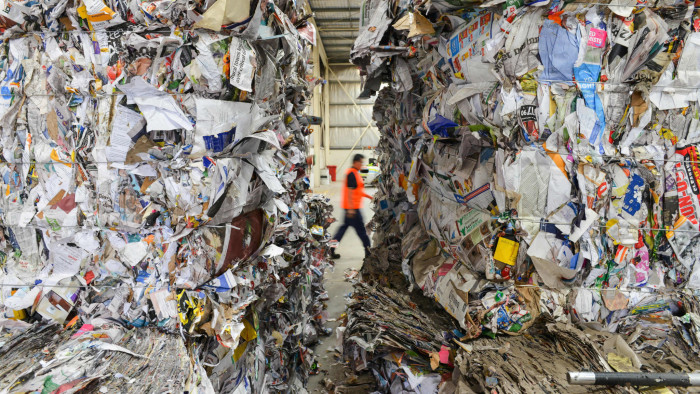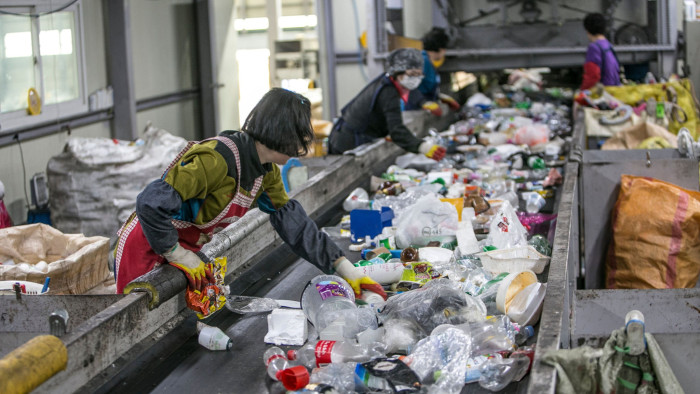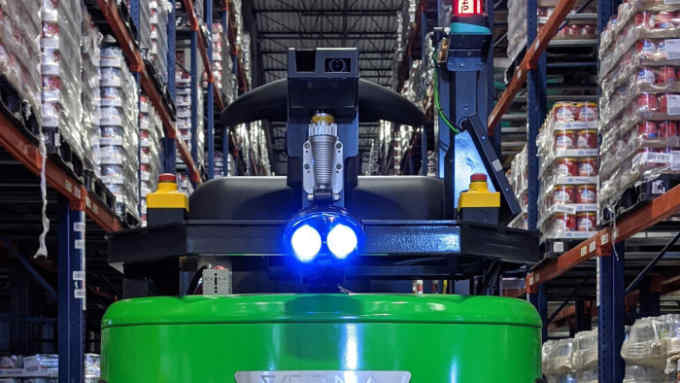Recyclers turn to AI robots after waste import bans

Roula Khalaf, Editor of the FT, selects her favourite stories in this weekly newsletter.
When China restricted the importation of recyclable waste products in 2018, many western companies turned to robotic technologies to strengthen their processing capabilities.
“The ban exposed how vulnerable the current infrastructure for recycling is,” says Chris Wirth, vice-president of marketing and business development for AMP Robotics, a Denver-based industrial recycling artificial intelligence company.
To recycle in a cost-effective, comprehensive and safe way, goods must be broken down into their constituent commodities to be sold on, in a process that has been likened to “unscrambling an egg”.
Roboticists think that computer vision, neural networks and modular robotics can enable a more intelligent, flexible approach to recycling. AI-enabled robotics can identify items based on visual cues such as logos, colour, shape and texture, sorting them and taking them apart.
It could for instance, spot a Nestlé logo depicting a cow and surmise that it is a dairy product. Such systems excel at identifying small items, such as the coffee pods used in Nespresso machines, which, while technically recyclable, are not always recycled. “You can categorise and subcategorise, and the robotics are getting smarter as a result of artificial intelligence,” says Mr Wirth.
Currently, waste products commonly move along a conveyor belt where they are sorted and sifted by a combination of machines and human workers. The work is dirty and dangerous for staff, who might handle everything from hypodermic needles to animal carcasses, used nappies to explosive propane cans.
Machinery is generally able to sort ready-to-recycle items but not to take products apart. Standard takeaway coffee cups and yoghurt pots only contain certain recyclable elements, with no easy way of disaggregating them.

AMP Robotics, which operates in the US, Canada, Japan and soon in Europe, installs its technologies into existing machinery to minimise the need for big infrastructure changes. It is also installing vision systems that provide data analytics that help the facilities to track materials processing and purity levels.
Taking products apart will become increasingly important for the recycling sector as more waste is electronic, such as smartphones, tablets, digital home appliances and electric vehicles. These contain often valuable materials such as gold, silver, platinum and cobalt.
Shahin Rahimifard, professor of sustainable engineering at the UK’s Loughborough University. sees the automotive sector as a prime target for more recycling, as cars are increasingly built with more electronics and electric vehicles contain higher value raw materials.
“Our current way of recycling cars focuses on extracting three core metals — steel, copper and aluminium — that account for around 60 per cent of the value,” he says. “In electric cars, most of the value will be the precious metals like gold and platinum which, by weight, could be only four or five per cent. So, we are moving from having 60 per cent of the weight giving 80 per cent of the recycled value, to more like 4 per cent.”
Prof Rahimifard’s team is developing a robotic dissembler that can deal with this fundamental shift in recycling economics.
Experts hope this combination of automation-driven efficiency and the ability to extract the more valuable materials found in our digital waste could help the recycling industry handle and repurpose more of our waste.
The Covid-19 crisis has heightened the economic imperative to improve recycling, as countries look to bring more parts of their supply chains closer to home. “In World War II, recycling wasn’t for the environment; it was for raw materials and the localisation of the supply chain,” says Mr Wirth, who believes that such logic is returning in addition to the ecological urgency of eliminating plastic waste.
Automation often stokes anxiety about mass unemployment, but the recycling sector has been struggling to find enough workers. The US waste and recycling industry has suffered labour shortages in recent years. By limiting the influx of foreign workers to do jobs locals are not keen on, the UK’s departure from the EU is expected to hit the UK’s waste management sector hard.
“This technology is creating a sustainable workforce for jobs that aren’t being filled,” says Mr Wirth. “These are the dull, dirty, dangerous kind of jobs which robotics and AI is perfect for.”

Comments